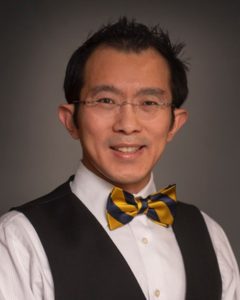 |
| Donny Hanjaya-Putra is an Assistant Professor in the Department of Aerospace and Mechanical Engineering, Bioengineering Graduate Program, as well as Chemical and Biomolecular Engineering at the University of Notre Dame. He earned his Bachelor degree in Chemical and Biomolecular Engineering from the University of Notre Dame in 2007. He completed his PhD in Chemical and Biomolecular Engineering from the Johns Hopkins University under the mentorship of Dr. Sharon Gerecht. His postdoctoral research training was conducted with Dr. Elliot L. Chaikof at the Wyss Institute for Biologically Inspired Engineering at Harvard Medical School.
His research focuses on the study of thrombosis and hemostasis, stem cell engineering, vascular and lymphatic morphogenesis, as well as synthesis of bio-inspired materials and tissue-engineered constructs. His lab is interested to understand what governs the formation of blood and lymphatic vessels from stem cells and how these insights can be used to develop novel therapies. He has received numerous awards, including NIH Maximizing Investigator’s Research Award (MIRA) R35, NSF CAREER Award, Career Development Award from American Heart Association, CMBE Young Innovator Award, and Siebel Scholar Award. Research projects in his lab are currently being supported by both federal and private funding agencies, including Indiana CTSI, NSF, NIH, Advanced Regenerative Manufacturing Institute / BioFab USA, and American Heart Association. |
Read Donny’s open access Emerging Investigator article Synthetic hyaluronic acid coating preserves the phenotypes of lymphatic endothelial cells, DOI D3BM00873H.
Check out our interview with Donny below:
How do you feel about Biomaterials Science as a place to publish research on this topic?
The Biomaterials Science is an internationally recognized journal to publish transformative research at the interface between biomaterials and medicine. It is an honor to publish our latest research in this high-impact journal and engage with the biomaterial community at international level.
What aspect of your work are you most excited about at the moment and what do you find most challenging about your research?
We are very excited about leveraging advances in biomaterials design and fabrication to unlock the therapeutic potential of stem cells for regenerative medicine and tissue engineering applications. One application that is particularly challenging is how to regenerate the lymphatic vasculatures. However, we are very excited and inspired by our talented and dedicated researchers who try to solve these problems using innovative approaches. A great example of it would be our most recent publication in Biomaterials Science, where our multidisciplinary research team came up with a synthetic coating method to culture lymphatic endothelial cells and preserve their phenotypes. Thus, we hope that this innovative solution can be broadly used to advance the fields of lymphatic biology and tissue engineering.
In your opinion, what are the most important questions to be asked/answered in this field of research?
Since the field of lymphatic biology is still relatively young, there are many unanswered questions surrounding the roles of lymphatic vasculatures in body hemostasis maintenance and the progression of various diseases. By leveraging stem cells and biomaterials design, we hope to be able to enhance our basic understanding of lymphatic vasculature as well as develop innovative therapeutics for a wide range of diseases that may involve lymphatic regeneration.
Can you share one piece of career-related advice or wisdom with other early career scientists?
As an early career scientist, it is important to be creative and persistent. Build a network of mentors and people with diverse background who are willing to support you.
Keep up to date with all of Donny’s research by checking out his lab’s website or by following @DHPGroup, @NDBioeng and @NBEngineering on X.












